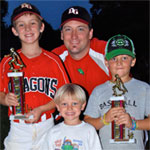First Basemen Position Essentials
First Basemen Fundamentals
1. Foot work receiving throw from infielder
2. Stretching with proper foot every time
As a right-hander, I always want to step with my left foot toward the throw. As a left-hander, always step with your right foot. This allows your body to stretch further with your glove hand to receive the ball sooner. The second part of stretching toward the throw, see the throw before you stretch. Try and time your stretch to catch the ball as far out as possible when your stretching foot lands. The last part of stretching is having your back foot on the bag in the proper spot. Make sure your foot on the bag is on the inside part of the bag allowing the runner access to step on the bag and avoid your foot. After you have caught the throw, remove your foot from the base.
3. Getting pulled off by bad throw
4. Holding runner on
Have your right foot against the front inside part of the bag closest to the pitcher with your left foot toward the pitcher (for righties). For lefties, your right foot against the front inside part of the bag and left foot down the line toward the batter with your toes pointing toward the pitcher. This will put your body in a better position to handle all throws from the pitcher. After pitcher commits to throw home, come off the bag under control and square your body to the plate in fielding position. Coming off the bag your steps will be right, left, right.
5. Throwing to pitcher covering first
For shorter throws, use underhand toss. Take ball out of glove and let pitcher see it, give him a firm toss (as soon as possible to give him time to locate the bag), chest high out in front of him, and let your momentum carry you toward pitcher. Longer throws require you to be more of a quarterback and lead the pitcher. Again, get him ball as soon as possible, out in front of him, chest high with a little something on it. For an in-between length throw, it’s always better to get your momentum going toward the pitcher and use the underhand toss, you may have to take an extra step or two in this case.
6. Positioning
Play as far off the base as you can and still comfortably get back to the bag on a ground ball.
7. First step quickness
This requires a good creep step. For righties, the step sequence is right-left. For lefties it’s the opposite, left-right. Hands should be out in front of you with weight on balls of feet, knees inside of feet, and feet spread wider than shoulder width in a good athletic position. Lots of players after their creep step like to take a little hop. Either way, creep step or creep step with a hop, the timing is you should be in your athletic fielding position as the ball crosses the plate.
8. How to think as a first baseman
You are the last line of defense and considered your infielders’ best friend. You must do everything in your power to stop the throw from the infielder so the runner does not have a chance to advance. On errant throws, catch the ball first. On ground balls, you have the luxury of the pitcher covering. Worse case scenario, block the ball, knock it down and you still have a chance to get the runner out. Ground balls in the hole may be a problem, but it is your responsibility to field your position. If you go for a ball and don’t get it, it is the pitcher’s responsibility to cover the bag. The one time you don’t go for a ground ball may be the one time it gets through and you could have reached it. Know the situation in the game ahead of time and know what you need to do in all situations before the pitch is thrown. Expect the ball.
9. Infielder Essentials
Creep Step
Fielding Position
Fielding Step
Lining Up Body to Throw
Drills
1. Throwing balls to first baseman covering bag. Left, right, up, down. Also make throws that will pull him off the bag.
2. Ground balls with pitcher covering first
3. Short hops and picks.
4. Throwing to second base on double plays.
Fun Advanced Drills
1. Make diving stops of ground balls.
2. Pop ups near the fence.

